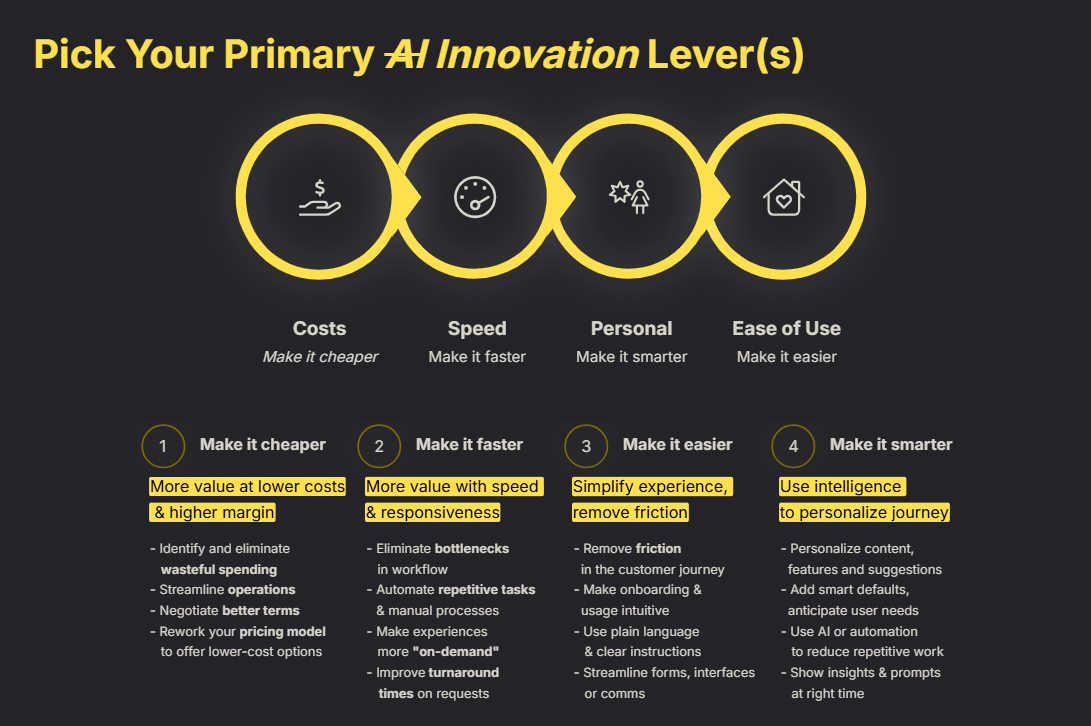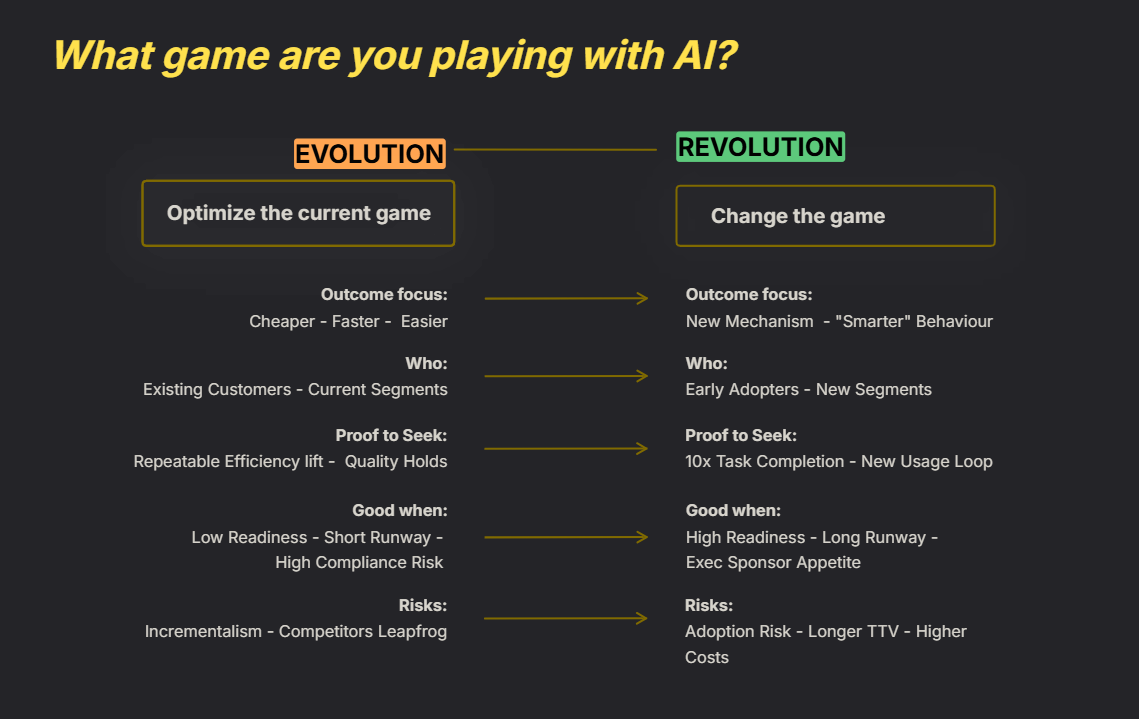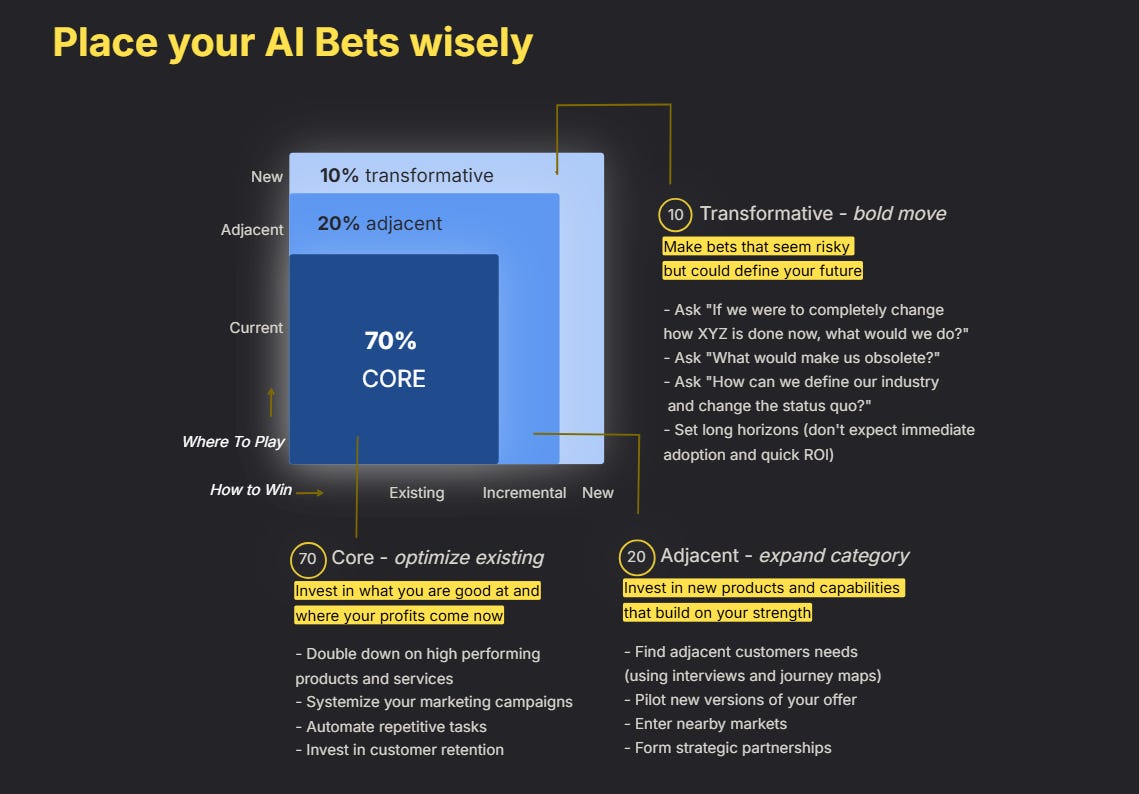Why Most Companies Are Asking the Wrong Questions About AI
The Four Strategic Frameworks That Stop You From Building AI Features Nobody Uses. [Slides Included]
When Elena Leonova walked onto the ProductLab Conference stage in Berlin, she opened with a poll that made the room shift uncomfortably in their seats.
“Am I the only one who’s been asked to do AI without a clear product strategy?”
Nearly 70% of hands went up.
As Chief Product Officer at Spryker (a B2B digital commerce platform serving large enterprises) and coach to 100+ product managers, Elena has spent years watching companies struggle with the same problem: everyone’s being told to “do something with AI,” but nobody knows what that something should be.
The result? Teams running around like headless chickens, shipping AI features that get 20% adoption rates, and wondering why their revolutionary technology feels more like expensive window dressing.
Elena’s talk wasn’t about prompts, tokens, or the latest model releases. It was about the strategic frameworks that determine whether your AI product becomes essential or gets killed in the next budget review.
The Real Problem: We’re Not Just Lacking Strategy—We’re Asking the Wrong Questions
Here’s what Elena has observed across dozens of companies: product teams are so focused on “Should we do AI?” that they never ask the question that actually matters.
The wrong question: “Should we add AI to our product?”
The right question: “What game are we playing, and what context demands our next move?”
Elena shared four brutal truths that most product leaders don’t want to admit. These aren’t theories—they’re patterns she’s seen repeatedly in established companies trying to evolve in the AI era.
BRUTAL TRUTH #1: Hype ≠ Strategy
The symptom: Your leadership team comes back from a conference buzzing about AI. Within a week, you’ve got a mandate to “AI-ify” everything. No clear outcomes. No defined value. Just AI for AI’s sake.
The reality: AI adoption hinges on clear strategic intent, not just excitement.
Elena breaks down what real strategic clarity looks like:
→ Point A: Where are you now? (Current state with hard numbers) → Point B: Where are you going? (Target state with measurable outcomes)
→ 3-5 bold bets: Specific hypotheses with customer proof
“You need to still have a clear strategy about what kind of change you are trying to create and why,” Elena emphasized. “You need to understand what kind of value you’re trying to create and make sure your customers want that value before you start thinking about AI features.”
Most companies skip Point A entirely. They can’t articulate their current baseline, which means they have no way to measure if AI actually improved anything.
Action item: Before your next AI roadmap discussion, force your team to complete this sentence: “We will know our AI investment succeeded when [specific metric] moves from [current number] to [target number] because our customers can now [specific outcome].”
BRUTAL TRUTH #2: AI Labels ≠ Value
The symptom: You slap “AI-powered” on existing features and wonder why adoption doesn’t change.
The reality: Simply adding “AI” to existing capabilities won’t inherently create value without a defined purpose.
Elena introduced a framework that cuts through the noise: The Four Innovation Levers.
Every successful product innovation moves the needle on at least one of these:
1. Make it Cheaper (Cost ↓ / Margin ↑)
→ Lower costs for customers or reduce your cost to serve
→ Example: AI-powered translation replacing human translators—still involves people for quality checks, but costs drop 60%
2. Make it Faster (Cycle Time ↓ / SLA ↑)
→ Compress time-to-outcome for customers
→ Example: Website builder that uses AI for layouts only wins if it actually gets customers to launch faster—not just make prettier pages
3. Make it Easier (Friction ↓ / Conversion ↑)
→ Remove steps, simplify workflows, reduce cognitive load
→ Example: Auto-filling forms based on previous context instead of making users type again
4. Make it Smarter (Relevance ↑ / AOV ↑)
→ Personalize experiences, anticipate needs, deliver context
→ Example: Recommendations that actually increase average order value, not just look clever
Elena ran a live poll asking which levers attendees were targeting with their AI features. The responses were scattered—compliance, adoption, data quality, strategy.
That’s the problem. When you don’t know which lever you’re pulling, you can’t measure if it’s working.
“When you implement an AI feature, you’re not just throwing an AI label on top of the feature,” Elena explained. “The value itself needs to be absolutely clear to the customer. You’re actually trying to move the needle on one of those four levers.”
Action item: Audit every AI feature on your roadmap. Force each one to declare which lever it’s pulling and what the measurable outcome is. If a feature can’t clearly articulate its lever, kill it or redesign it.
BRUTAL TRUTH #3: Innovation ≠ Always the Right Answer
The symptom: Everyone wants to “innovate” with AI, build the revolutionary product, change the game. Meanwhile, your core business is bleeding customers because basic workflows are slow.
The reality: Understanding if your goal is evolution (efficiency) or revolution (reinvention) is critical. “We need to innovate” isn’t a strategy.
This is where Elena’s framework gets surgical. She introduced a critical distinction most teams never make:
What Game Are You Playing With AI?
EVOLUTION: Optimize the Current Game
Outcome focus: Cheaper, Faster, Easier
Who: Existing customers, current segments
Proof to seek: Repeatable efficiency lift, quality holds
Good when: Low readiness, short runway, high compliance risk
Risks: Incrementalism, competitors leapfrog you
REVOLUTION: Change the Game
Outcome focus: New mechanism, “smarter” behavior
Who: Early adopters, new segments
Proof to seek: 10x task completion, new usage loops
Good when: High readiness, long runway, exec sponsor appetite
Risks: Adoption risk, longer time-to-value, higher costs
“Most of the time companies are lacking a successful strategy for how to actually make bets,” Elena said. “With AI, you need to start making even bolder bets, but at the same time you need to have a strategy behind it.”
Elena emphasized that established businesses—companies that have been around for decades or centuries—are in a fundamentally different position than AI-native startups. They have existing products, existing customers, and existing revenue streams.
“We’re not talking about the new startup that is starting from scratch. They have existing products with existing customers and that’s where the majority of their money is coming from. So you have to continue to optimize it.”
But here’s where it gets interesting. You can’t just pick one game and ignore the other.
BRUTAL TRUTH #4: Focused Bets > Spray-and-Pray
The symptom: Your team is running 15 AI experiments with no clear success criteria, no kill dates, and no portfolio strategy.
The reality: Random experimentation without clarity, alignment, and a disciplined portfolio leads to poor outcomes and resource drain.
Elena introduced a betting framework adapted from portfolio management theory: The 70-20-10 Model.
But here’s the twist—you can’t apply the same percentages to every company.
Place Your AI Bets Based on Your Context:
CORE (Optimize Existing): → Double down on high-performing products
→ Systemize marketing campaigns
→ Automate repetitive tasks
→ Invest in customer retention
ADJACENT (Expand Category): → Find adjacent customer needs
→ Pilot new versions of your offer
→ Enter nearby markets
→ Form strategic partnerships
TRANSFORMATIVE (Bold Moves): → Ask “If we were to completely change how XYZ is done, what would we do?”
→ Ask “What would make us obsolete?”
→ Set long horizons (don’t expect immediate adoption)
But the allocation changes based on your context:
Venture-Backed (Chasing a round)? → Bias Revolution for narrative and optionality while managing runway
→ 20/30/50 (Core/Adjacent/Transform)
Public Company (Margin pressure)? → Bias Evolution—operational efficiency is oxygen for stock performance
→ 80/15/5 (Core/Adjacent/Transform)
Profitable & Private (Sustainable growth)? → Run a barbell strategy—protect core, fund bold bets
→ 60/20/20 (Core/Adjacent/Transform)
“The thing is that you cannot apply this model to any company,” Elena warned. “It depends. Context decides.”
When asked about the biggest challenges teams face with AI strategy, the ProductLab audience responses were telling: compliance, adoption, data quality, capacity, resources, strategy itself.
Elena’s point:
“There’s no consistent answer that people have. Pretty much across the board, people talk about that yes, everybody has a mandate to go and do AI, but at the same time there’s like hundreds of reasons why—on the surface it seems like other companies are really successful, but most of the time they are not. They’re also struggling to understand what they actually do.”
The critical rule: Every bet must have: → Success KPI
→ Guardrail KPI
→ Kill/Scale date
→ Quarterly rebalancing
“Don’t ask ‘Should we do AI?’ Ask: What’s the right balance for our context—now? Then start making your decision.”
From Theory to Action: What to Do Monday Morning
Elena closed with a challenge to the audience: change the conversation entirely.
Stop asking:
Should we do AI?
Are our customers ready for AI?
What AI features should we build?
Start asking:
What is the right context for my company? (Venture-backed? Public? Private?)
What game are we playing? (Evolution or Revolution?)
Which value lever are we pulling? (Cheaper? Faster? Easier? Smarter?)
What’s our betting portfolio? (70-20-10? Something else?)
“Go with that to your leadership team, which will make you more strategic than anybody else,” Elena said. “And I can guarantee you that if you do that, you’re going to be definitely seen as more strategic, but also you’re going to be speaking the language that business understands more than just if you were talking about a specific product feature.”
The E-Commerce Reality Check
During Q&A, Elena was asked about the biggest AI use case in e-commerce given her Spryker background.
Her answer was refreshingly honest: “To be honest, I don’t know what’s going to be the next thing because the world is changing quite a lot.”
She explained that large B2B manufacturers (like Siemens Healthcare, which makes medical devices) aren’t easily adopting AI tools due to compliance concerns. But smaller e-commerce companies face a different threat: discovery moving entirely to LLMs.
“It’s easy to go to ChatGPT and say, ‘I have these pants, I have these shoes, find me a t-shirt or a top that is going to go with this.’ I don’t need to go and search even on Amazon for that because maybe that product is not there.”
The takeaway? The channel itself might change, but the strategic frameworks remain constant. You still need to know:
Who your customer is
What value you’re creating for them
Whether they’re willing to pay for that solution
Whether you can execute it
“You should not be thinking from the types of product. You need to be thinking about who your customer is. What kind of value do you want to give them? Actually test for their willingness to pay for that solution and then are you actually able to execute for it.”
Your Move
Elena’s frameworks aren’t theoretical constructs—they’re battle-tested approaches from someone who’s been in the trenches building products for established enterprises that can’t afford to chase every shiny AI object.
The difference between companies that succeed with AI and those that burn cash on unused features comes down to one thing: strategic clarity.
You can have the best models, the smartest engineers, and the biggest budget. But if you don’t know what game you’re playing, which lever you’re pulling, and what context you’re operating in, you’re just another team running around with your hair on fire wondering why “AI” isn’t working.
Start with one thing this week: Get brutal clarity on whether you’re playing evolution or revolution. That single decision will cascade into better bets, clearer priorities, and AI products people actually want to use.
The brutal truth? Most companies won’t do this work. They’ll keep spray-and-praying, keep slapping “AI” labels on features, and keep wondering why adoption stays stuck at 20%.
Don’t be most companies.
This article is based on Elena Leonova’s talk “The Brutal Truth About AI Product Success” delivered at ProductLab Conference 2025 in Berlin. The conference brings together 250+ senior product managers and leaders to tackle the hardest challenges in product management.









